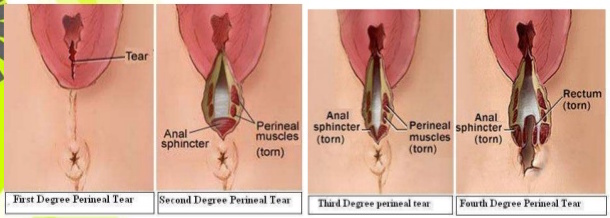Definition of "Perineal tear"
Last modified: 2 hours
It's where as a result of delivery of a baby - usually on the larger side - an accidental tear is made to the perineum.
Childbirth, because the stretching causes straining of this wall. If you think about the big size of the head, giving birth without some degree of trauma is really quite difficult.
If bub's face is facing forward. Mom who hasn't given birth before. Or a big bub.
It's easiest to define it by what it doesn't involve. 1st degree doesn't involve the perineal muscles. 2nd degree doesn't involve the anal muscles. 3rd degree doesn't involve the anal mucosa.
There can be chronic pain where the tear is. Sex can be painful. And depending on the degree of the tear, there can be lost control over poop.
Perineal tear is an unintended laceration of the skin and other soft tissue structures separating the vagina from the anus. Tears vary in severity.
Patient information
What is a perineal tear?It's where as a result of delivery of a baby - usually on the larger side - an accidental tear is made to the perineum.
What is the perineum?
It's the wall between the vagina and anus, and everything that is in it.
Cause
- It mainly occurs in women as a result of vaginal childbirth, which strains the perineum
- In humans, the head of the fetus is so large in comparison to the size of the birth canal, term delivery is rarely possible without some degree of trauma. As the head passes through the pelvis, the soft tissues are stretched and compressed
Patient information
What causes a tear in the wall between the vagina and anus?Childbirth, because the stretching causes straining of this wall. If you think about the big size of the head, giving birth without some degree of trauma is really quite difficult.
Risk factors
- Fetal head is oriented OP (occiput posterior, i.e. face forward)
- Primip (mother has not given birth before)
- Fetus is large
Patient information
What makes it more likely that you tear the wall between the vagina and anus?If bub's face is facing forward. Mom who hasn't given birth before. Or a big bub.
Classification
- 1st degree tear, where laceration is limited to the fourchette and superifcial perineal skin or vaginal mucosa
- 2nd degree tear, where laceration extends beyond fourchette, perineal skin and vaginal mucosa - to perineal muscles and fascia, but not the anal sphincter
- 3rd degree tear, where the fourchette, perineal skin, vaginal mucosa, muscles, and anal sphincter are torn. They can be subdivided into:
- 3a: Partial tear of the external anal sphincter involving <50% thickness
- 3b: >50% tear of the external anal sphincter
- 3c: Internal sphincter is torn
- 4th degree tear, where the fourchette, perineal skin, vaginal mucosa, muscles, anal sphincter, and rectal mucosa are torn

Patient information
Whoa... That was a lot of words. So in simple terms, what's the difference between a 1st, 2nd, 3rd, and 4th degree tear?It's easiest to define it by what it doesn't involve. 1st degree doesn't involve the perineal muscles. 2nd degree doesn't involve the anal muscles. 3rd degree doesn't involve the anal mucosa.
Tx
- Superficial tears require no Tx
Complications
- Chronic perineal pain
- Dyspareunia (painful sex)
- Fecal incontinence
- Fecal urgency
Patient information
What bad things can happen as a reuslt of a tear in the wall between the vagina and anus?There can be chronic pain where the tear is. Sex can be painful. And depending on the degree of the tear, there can be lost control over poop.
Prognosis
- 1st and 2nd degree tears rarely cause long term problems
- In women who've experienced a 3rd or 4th degree tear, 70% are asymptomatic after 12 months
- Severe tears can cause significant bleeding, long-term pain, or dysfunction
Epidemiology
- The majority of tears are superficial
- 1st and 2nd degree perineal tears are the most common complicating condition for vaginal devlieries
See also
- Episiotomy (intentional laceration, to facilitate delivery)
Synonyms:
1st degree tear
2nd degree tear
3a tear
3b tear
3rd degree tear
4th degree tear
First degree tear
Fourth degree tear
Perineal repair
Perineal resuture
Perineal resutured
Perineal suture
Perineal sutured
Perineum repair
Perineum suture
Perineum sutured
Perineum tear
Perineum torn
Repair of perineum
Repair perineum
Repair the perineum
Resutured perineum
Second degree tear
Tear
Third degree tear
Tore perineum
Find a practitioner
Practitioner count: 0
Sponsor a disease. And see how your proceeds help.
$1
Express interest
$10
Write text
$40
Write FAQ
$100
Snap photos
$400
Record audio
$1k
Produce video
$4k
Interview experts